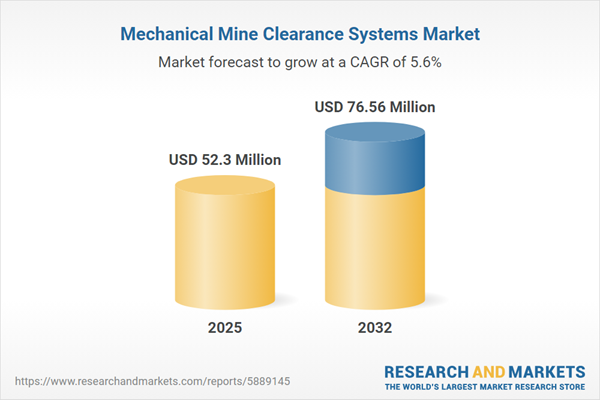Speak directly to the analyst to clarify any post sales queries you may have.
Mechanical mine clearance systems are transforming the approach to global demining. By prioritizing advanced technology and risk mitigation, these systems give senior decision-makers the tools to maintain operational continuity, support regulatory alignment, and enhance project outcomes—even in highly complex and evolving environments.
Market Snapshot: Mechanical Mine Clearance Systems Market Analysis
The global mechanical mine clearance systems market continues to advance, valued at USD 49.58 million in 2024 with a 5.58% compound annual growth rate (CAGR). Expansion is shaped by the strategic adoption of advanced demining solutions within both defense and civilian programs. By integrating digital technologies into diverse project cycles, organizations modernize operations and adopt digital tools needed for current and future demands. Improved supplier frameworks and governance structures allow executive teams to proactively manage regulatory developments, operational risk, and capital allocation. Streamlined sourcing models reinforce effective risk management, ultimately supporting compliance and enterprise resilience across procurement landscapes.
Scope & Segmentation of the Mechanical Mine Clearance Systems Market
- Product Types: Blast-resistant blade systems, flail mechanisms, heavy rollers, and plough attachments contribute to operational flexibility, raising protection and effectiveness for military, humanitarian, and reconstruction projects.
- Deployment Capabilities: Autonomous, manual, and remote-control systems are utilized to minimize onsite risks. Flexible operation ensures adaptability to diverse terrains and varied threat scenarios.
- Platforms: Armored vehicles, tracked units, wheeled machines, and unmanned ground vehicles are deployed to address distinct logistical and operational priorities, accommodating a range of mission scopes.
- Operation Modes: Modular configurations and dual-option (autonomous or remote-controlled) operation streamline deployment, aligning with rapidly changing project requirements.
- End Uses: These systems support humanitarian demining, military engineering, agricultural reclamation, and construction site preparation, enabling optimized risk control and expedited clearance timelines.
- Propulsion Technologies: Diesel, electric, and hybrid engines—including both series and parallel formats—address sustainability objectives, emission targets, and regulatory readiness.
- Geographies: Americas, Europe, Middle East & Africa, and Asia-Pacific comprise active regions. Countries such as the United States, Canada, Germany, China, and India play crucial roles in supply chain durability and regulatory development.
- Key Players: DOK-ING d.o.o., Pearson Engineering Ltd, Hydrema A/S, MineWolf Systems AG, Saab AB, FAE Group S.p.A., Milrem Robotics AS, BAE Systems plc, Caterpillar Inc., and Textron Systems Corporation drive innovation and set performance standards.
Key Takeaways for Senior Decision-Makers
- Adoption of digital twin technology and integrated sensors enhances predictive maintenance, supporting asset longevity and efficient management practices across operational fleets.
- Modular system architecture enables rapid reconfiguration for a variety of missions, reducing operational downtime and responding effectively to evolving objectives.
- Unmanned and autonomous systems are increasingly prioritizing personnel safety, allowing organizations to meet challenging operational requirements in hazardous settings.
- Use of electric and hybrid propulsion meets ongoing sustainability and environmental expectations, aligning with forward-looking business commitments.
- Specialized services, such as tailored technical training and customized systems, encourage stakeholder collaboration and promote incremental, site-level performance improvements.
Tariff Impact: Navigating Policy Complexities
Recent tariffs on imported components in the United States have prompted manufacturers to diversify and strengthen supply chains, creating greater operational resilience. By building redundancies within supplier ecosystems, organizations can safeguard project delivery and cost management, ensuring technology access remains stable despite policy shifts.
Methodology & Data Sources
The findings in this report are based on a combination of executive interviews, on-site field observations, regulatory reviews, and patent analysis. Industry specialists validate these sources to provide reliable and actionable insights for procurement and operations leadership.
Why This Report Matters
- Enables organizations to benchmark procurement and deployment strategies, objectively enhancing market presence within dynamic demining sectors.
- Supports executive teams facing policy fluctuations, helping uphold compliance and budget controls in varied operational geographies.
- Delivers actionable insight on technology and capability trends, driving better knowledge transfer and stronger operational outcomes across organizations.
Conclusion
Mechanical mine clearance systems deliver robust technical and strategic value in complex demining environments. Staying abreast of technological and regulatory trends ensures preparedness and underpins sustained project confidence.
Additional Product Information:
- Purchase of this report includes 1 year online access with quarterly updates.
- This report can be updated on request. Please contact our Customer Experience team using the Ask a Question widget on our website.
Table of Contents
3. Executive Summary
4. Market Overview
7. Cumulative Impact of Artificial Intelligence 2025
Companies Mentioned
The companies profiled in this Mechanical Mine Clearance Systems market report include:- DOK-ING d.o.o.
- Pearson Engineering Ltd
- Hydrema A/S
- MineWolf Systems AG
- Saab AB
- FAE Group S.p.A.
- Milrem Robotics AS
- BAE Systems PLC
- Caterpillar Inc.
- Textron Systems Corporation
Table Information
| Report Attribute | Details |
|---|---|
| No. of Pages | 195 |
| Published | November 2025 |
| Forecast Period | 2025 - 2032 |
| Estimated Market Value ( USD | $ 52.3 Million |
| Forecasted Market Value ( USD | $ 76.56 Million |
| Compound Annual Growth Rate | 5.5% |
| Regions Covered | Global |
| No. of Companies Mentioned | 11 |







